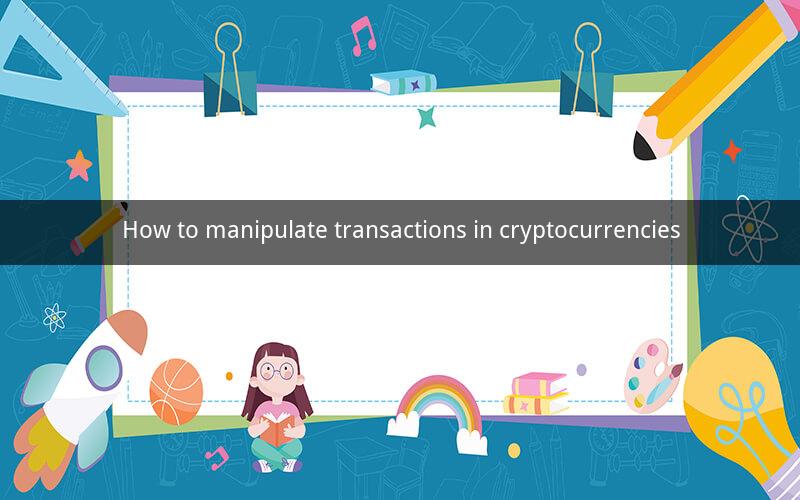
Cryptocurrency Transactions Manipulation: A Comprehensive Guide
Table of Contents
1. Introduction to Cryptocurrency Transactions
2. Understanding the Blockchain Technology
3. The Risks of Manipulating Cryptocurrency Transactions
4. Legal Implications of Transaction Manipulation
5. Methods to Manipulate Cryptocurrency Transactions
5.1. Transaction Malleability
5.2. Double Spending
5.3. Transaction Reversal
5.4. Phishing Attacks
5.5. Malware Attacks
6. Preventing Cryptocurrency Transaction Manipulation
7. Conclusion
1. Introduction to Cryptocurrency Transactions
Cryptocurrency transactions are digital exchanges of value that occur on a decentralized network called the blockchain. Unlike traditional banking systems, cryptocurrencies operate without a central authority, making them a popular choice for those seeking financial freedom and privacy.
2. Understanding the Blockchain Technology
Blockchain technology is the backbone of cryptocurrencies. It is a decentralized ledger that records all transactions across a network of computers. Each transaction is verified by network nodes, and once confirmed, it is added to a new block, which is then linked to the previous blocks, forming a chain of blocks.
3. The Risks of Manipulating Cryptocurrency Transactions
Manipulating cryptocurrency transactions can have severe consequences. It can lead to financial loss, legal repercussions, and damage to one's reputation. Moreover, it can undermine the trust in the cryptocurrency ecosystem, which is crucial for its long-term sustainability.
4. Legal Implications of Transaction Manipulation
Transaction manipulation in cryptocurrencies is illegal in many jurisdictions. It can be considered as fraud, hacking, or theft, depending on the nature of the manipulation. Those found guilty of such activities can face substantial fines and imprisonment.
5. Methods to Manipulate Cryptocurrency Transactions
5.1. Transaction Malleability
Transaction malleability refers to the ability to alter the unique identifier (transaction ID) of a cryptocurrency transaction. This allows an attacker to modify a transaction without the recipient's knowledge, leading to potential financial loss.
5.2. Double Spending
Double spending occurs when a user attempts to spend the same cryptocurrency twice. This can be achieved by manipulating the blockchain or exploiting vulnerabilities in the wallet software. Double spending can lead to a loss of confidence in the cryptocurrency network.
5.3. Transaction Reversal
Transaction reversal is a method used to cancel a transaction after it has been confirmed. This can be done by manipulating the blockchain or exploiting vulnerabilities in the wallet software. However, reversing a transaction is generally not possible without the consent of both parties involved.
5.4. Phishing Attacks
Phishing attacks involve tricking users into revealing their private keys or other sensitive information. Once the attacker gains access to this information, they can manipulate transactions to their advantage.
5.5. Malware Attacks
Malware attacks can compromise the security of a user's device and allow an attacker to manipulate transactions. This can be achieved by infecting the device with a trojan horse or ransomware.
6. Preventing Cryptocurrency Transaction Manipulation
To prevent cryptocurrency transaction manipulation, users should take the following precautions:
- Keep private keys secure: Never share private keys with anyone and store them in a secure location.
- Use reputable wallets: Choose a wallet that has a strong reputation and implements robust security measures.
- Stay informed: Keep up-to-date with the latest developments in cryptocurrency security and be aware of potential vulnerabilities.
- Use two-factor authentication: Enable two-factor authentication on all cryptocurrency accounts to add an extra layer of security.
- Regularly update software: Keep your operating system, wallet software, and antivirus software up-to-date to protect against malware attacks.
7. Conclusion
Manipulating cryptocurrency transactions is illegal and unethical. It can lead to severe consequences for the attacker and undermine the trust in the cryptocurrency ecosystem. By following the precautions outlined in this guide, users can help prevent transaction manipulation and ensure the security of their cryptocurrency investments.
FAQs
1. What is transaction malleability?
- Transaction malleability refers to the ability to alter the unique identifier of a cryptocurrency transaction, allowing an attacker to modify the transaction without the recipient's knowledge.
2. How can double spending be prevented?
- Double spending can be prevented by implementing robust security measures, such as using a secure wallet and staying informed about potential vulnerabilities.
3. Can a transaction be reversed after it has been confirmed?
- Generally, reversing a confirmed transaction is not possible without the consent of both parties involved. However, certain blockchain protocols may offer dispute resolution mechanisms.
4. What are phishing attacks in cryptocurrencies?
- Phishing attacks involve tricking users into revealing their private keys or other sensitive information, which can be used to manipulate transactions.
5. How can malware attacks be prevented?
- Malware attacks can be prevented by keeping your operating system, wallet software, and antivirus software up-to-date and avoiding suspicious links or email attachments.
6. What is the role of blockchain technology in preventing transaction manipulation?
- Blockchain technology ensures the integrity and immutability of cryptocurrency transactions, making it difficult for attackers to manipulate them.
7. Can transaction manipulation be detected?
- Yes, transaction manipulation can be detected through various methods, such as monitoring network activity and analyzing transaction patterns.
8. How can users protect their private keys?
- Users can protect their private keys by storing them in a secure location, using hardware wallets, and avoiding sharing them with anyone.
9. What legal implications can arise from transaction manipulation?
- Transaction manipulation can lead to legal repercussions, such as fraud charges, hacking charges, or theft charges, depending on the nature of the manipulation.
10. How can users stay informed about cryptocurrency security?
- Users can stay informed about cryptocurrency security by following reputable sources, joining online forums, and participating in community discussions.